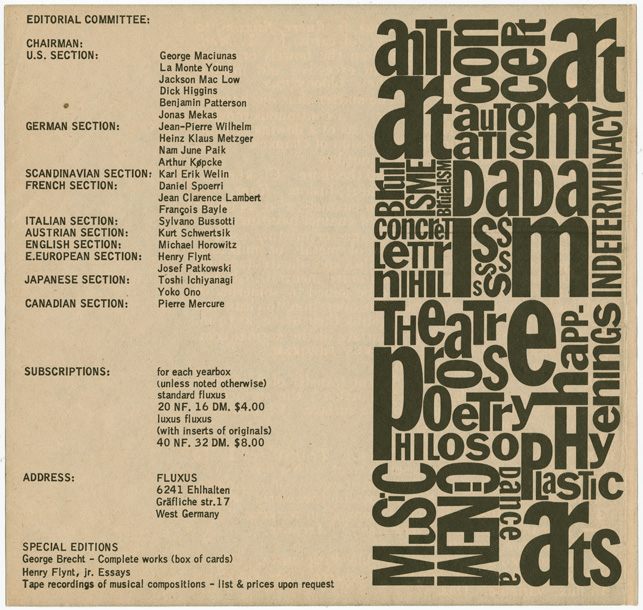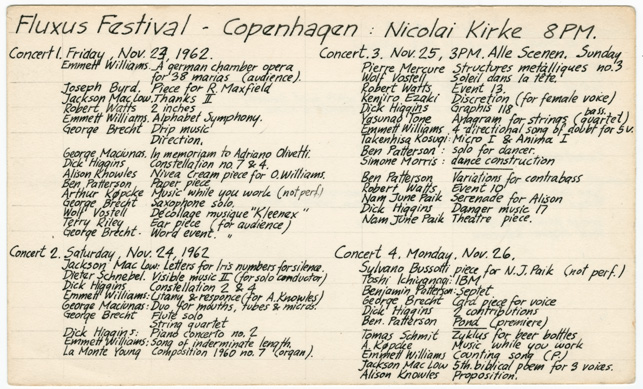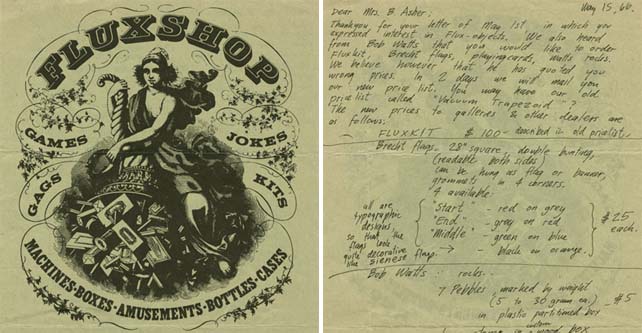
George Maciunas. Page from 1962 prospectus laying out his grand plans for Fluxus and exemplifying Fluxus’s unique design sensibility and brilliant typography. Silverman Fluxus Archives, V.F.B.
Are you intrigued by artists’ multiples? Engaged by innovative typography? Do you want to learn more about the roots of Conceptual and performative art today, and how artists’ innovation influences curatorial practice?
If so, then I am pleased to inform you that after several years, and more than a few surprises, the Gilbert and Lila Silverman Fluxus Collection Archives are open for research. Scholars will use the archives to study the history of Fluxus and its related artists. But while you might never use the archives, my work as an archivist still has an impact on your experience of Fluxus art at the Museum. The decisions made by myself and the other members of the Fluxus team affect what goes into the galleries, and how those objects are presented to the public.
When Fluxus collectors Gilbert and Lila Silverman donated their vast collection to MoMA in 2008, we didn’t know what we were getting ourselves into. Before it expanded into performance, Fluxus was founded as an international publishing company by George Maciunas. Games, printed materials, and other multiples by various artists were united by Maciunas’s unique design sensibility and brilliant typography. This amazing collection—the world’s largest—had been carefully built for decades by Fluxus scholar Jon Hendricks, who aimed to present a complete history of Fluxus: not just artworks, but documentation and books as well. MoMA decided to split the Silverman Collection into three parts: works of art to the Department of Prints and Illustrated Books, for their facility at handling editions; documentation to the Museum Archives; and publications to the Library.
For the past two years, I’ve been the archivist responsible for processing the collection’s many wonderful manuscripts, notes, letters, and countless other documents into an organized research collection. That day has finally arrived—but getting here has been a long, strange journey.

George Maciunas kept index cards which listed the works that were performed at concerts and festivals organized by him and his fellow artists. Along with photographs and recordings, written accounts such as these are the only records we have of such historical performances. Silverman Fluxus Archives, V.D.1.8.
Fluxus thwarts all attempts at categorization. How can one distinguish “artwork” from “document,” when Fluxus artists actively strove to break down the border between art and life? How can we exhibit a work of performance art, when all that remains of it is a few photographs and written accounts? These are the sorts of documentary objects that researchers expect to find in archives, but as curators seek to display ephemeral and other dematerialized artworks, they are increasingly included in art exhibitions.

The image on the left is a lovely example of George Maciunas’s graphic design work, which is certainly a work of art, but as he used it as stationery—the letter to the right was written on its back in 1966—it’s also an important archival document. Detail of Fluxshop stationery, with letter from George Maciunas to Betty Asher on verso, Silverman Fluxus Archives, V.A.1.1.
Such quandaries are essential to understanding Fluxus. But they are particularly troublesome for an institution like MoMA, which is accustomed to maintaining separate departments for different types of objects. It’s no secret that MoMA didn’t collect many Fluxus works in the 1960s and 1970s, at the time of their creation, which means that the Silverman Collection fills a very significant gap. But in processing the archives, I came to understand our forebears’ reluctance: Fluxus is too fluid, too rebellious, too anti-institutional to enter an institution without a fight. It’s too many things at once.
That’s why myself and the other members of the Fluxus team quickly realized that we’d have to take a cue from Fluxus itself, and learn to be a little more fluid ourselves. We understood that sometimes artifacts need to be considered artworks, and other times works of art function like documents. It means that serious Fluxus researchers may need appointments with all three departments. But it also means that researching Fluxus will be as much of an adventure as processing it was.
To learn more about Fluxus, the Silverman Collection, or its processing, check out the finding aid online.
The Silverman Fluxus Archives can be consulted by appointment at the MoMA Archives reading room at MoMA QNS; open Mondays, 11:00 a.m. to 5:00 p.m. Appointments can be made through the Archives contact form.


